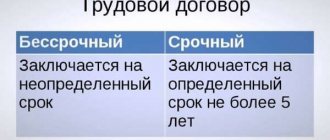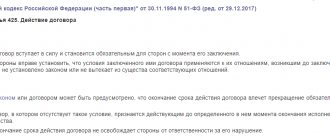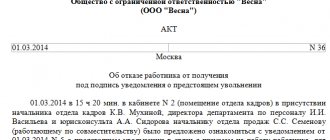Internal labor regulations, discipline
Internal regulations are created so that the organization operates stably in any conditions. For this purpose, a local regulatory act is drawn up. Managers are responsible for the development; the document must be present in each of the src=”https://naimtruda.com/wp-content/uploads/2018/10/1488801815_konsultaciya-yrisa-1100×733.jpg” class=”aligncenter” width= "1100″ height="733″[/img]
Here are just some of the questions that should be included in the document:
- Incentives and penalties applied to employees.
- Time allocated for rest.
- Work mode.
- Sections on the rights, duties and responsibilities of each of the interested participants in the relationship.
- Procedure for hiring and dismissing employees.
There is no unified form for the document, so each company develops its own version. The main thing is to rely on the specifics of the activity.
What is considered a violation
Employees of budgetary organizations are required to comply with the general requirements of labor legislation and local regulations. This is approximately what Article 189 of the Labor Code of the Russian Federation sounds like.
Internal work rules are the main and important local act regulating the behavior of personnel. If it is approved, then a sample order will not be needed. They also distinguish technological and production disciplines, which are also relevant to the topic of the article, because thanks to them, order is ensured in production, technological requirements and conditions are met. Here are the most common violations:
- being late for work or leaving early without permission;
- absenteeism;
- dishonest performance of labor duties;
- violation of labor protection rules;
- showing up at work under the influence of alcohol or drugs;
- theft, embezzlement or damage to the employer's property;
- disclosure of trade secrets;
- waiver of mandatory medical examination or training;
- insubordination;
- ignoring the rules, instructions and orders of management adopted in the organization;
- immoral act (often found in educational institutions).
We talked about what to do with violators and how to punish them. Now we’ll talk about how to draw up an order for punishment in the form of a reprimand, and we’ll draw up a sample.
Penalties for violation
Here are the main types of punishments according to Russian legislation:
- dismissal;
- reprimands;
- comments.
Federal laws, statutes and discipline regulations may address other types of penalties imposed on employees. Therefore, orders regarding penalties are considered illegal.
Is it possible to replace a reprimand with a fine?
The concept of a fine is absent in labor legislation, so be careful and do not use such terms in local acts of the enterprise, especially do not apply such measures as a disciplinary sanction. An order to impose fines for violation of labor discipline will be illegal and can easily be canceled in court.
Financial penalties may affect the amount of the premium. But even here you need to be extremely careful in choosing wording. Under no circumstances should you write that a reduction in bonus is a disciplinary measure. Typically, the Bonus Regulations state that if there is a “remark” or “reprimand” in the reporting month, no bonus will be awarded. That is, for an offense you will apply a legal penalty, but you will punish financially indirectly. It is legal.
Regulations on fines
If it is accepted at the enterprise, then the conditions must be described. Most often, employees are deprived of bonuses if they violate any established standards.
But in this case, management is at great risk. After all, no problems will arise if someone wants to prove the illegality of such measures.
The form of drawing up the order is arbitrary. The following information must be present:
- Signature of the employer himself.
- The type of punishment that is applied in a particular case.
- The circumstances under which the offense was committed. There must also be information regarding the severity of the guilt.
- The act itself. It is also necessary to provide links to regulatory documents, general and local, where it is written that such actions are unacceptable.
- Full name of the culprit, mandatory indication of the exact position.
- Name and number of the document, date of publication.
- The name of the organization itself.
Rules and procedure for drawing up an order
The order is drawn up in any form. We invite you to familiarize yourself with the information contained in a sample order for a reprimand for violation of labor discipline. It must contain the following information:
- name of the organization (letterhead may be used);
- name, number and date of publication of the document;
- FULL NAME. and the position of the offending employee;
- committed misconduct with references to legislation, employment contract and (or) local regulations of the company;
- the circumstances of the offense and the severity of the guilt;
- type of punishment applied (reprimand);
- employer's signature.
Sample order for punishment for violation of labor discipline

Also, for educational purposes, it is permissible to use as a template a sample order to issue a warning to an employee in connection with a violation of discipline. An order is issued when the employer decides not to punish the employee, but to limit himself to an oral warning about the need to comply with the procedure established at the enterprise.
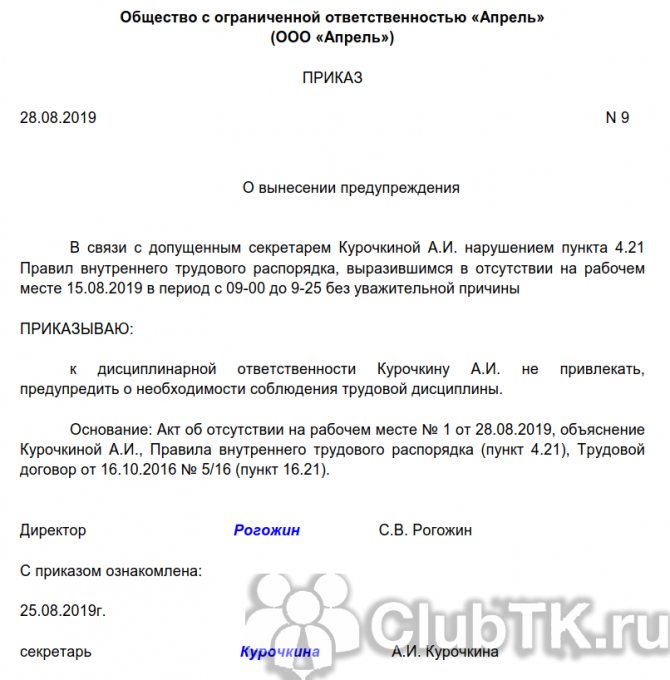
Sometimes an employer who has shown loyalty to an offending employee does not use a sample order to warn an employee, but limits himself to issuing instructions that apply to all personnel.
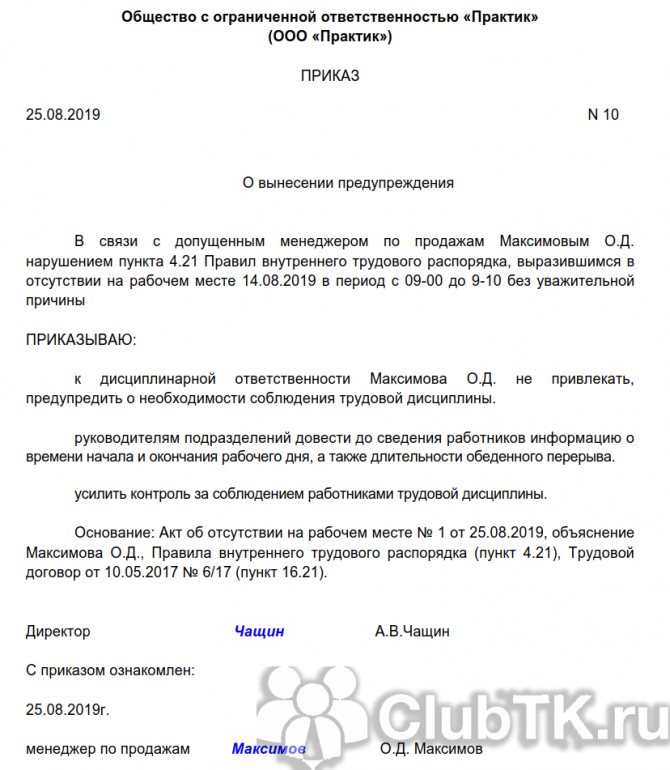
The citizen’s order must be reviewed and signed within 3 days. A copy of the order is included in the employee’s personal file.
If the employee refuses the request to sign the order, the employer will have to draw up a report about this fact in the presence of two witnesses.
There is a limited period for imposing a penalty, which is equal to one month from the date of violation. After 6 months, no punishment is applied.
Is it effective to apply a fine system for an enterprise?
Material sanctions are a convenient and logical tool. Many managers think that with its help it is easy to maintain discipline in the team. The level of production processes really increases with the proper use of such systems.

The main thing is to clearly define the connection between specific actions and the consequences that follow. This is an excellent option if you need to make sure that no one is late for the start of a work shift, for example.
Material sanctions increase the company's manageability. But if you go too far with such decisions, they can be harmful.
How to create an order
There is no unified form, but it must be completed properly. Draw up a document according to the rules that are accepted in the organization.
Step 1. In the header, indicate the registration details of the institution.
Step 2. Below is the date and number of the order.
Step 3. In the main part, state what happened, how the offense was recorded, whether there are witnesses, list the documents that were drawn up: a memo, an employee’s explanatory note, etc. If it is established that the employee previously committed such violations at least once, then this should be mentioned and the measures that have been taken should also be described. For example, a warning or reprimand. And if an order for reprimand was issued, then provide its details - it will also serve as the basis for a new punishment.
Step 4. The document is signed by the head of the organization.
Step 5. The employee must be familiarized with the punishment. In confirmation, he must sign the order.
What other advice do they give to managers?
The manager must clearly understand when fines are appropriate and when it is worth applying another type of impact. Sanctions are justified if the following conditions are met:
- the director’s orders are ignored in whole or in part;
- absence from work during the day without warning;
- fictitious sick leave;
- falsification of documents, even valid reasons;
- systematic delays;
- appearing drunk, drinking alcoholic beverages;
- when specialists managing a department hide the violations of their subordinates;
- if department heads give knowingly false information.
Most employees have a negative attitude towards such changes. Therefore, the number of conflicts may increase. Rewards work much better than punishments, this has been proven in all circumstances.
If fines are constantly applied at an enterprise and have become almost the norm, this is a bad sign for a manager. This means that production processes and people management are not nearly as efficient as they should be.
Along with fines, it is worth introducing a motivation system at the same time. Then employees will have a greater desire to prove themselves and achieve their goals. The main thing is that everyone understands what actions are taken to receive rewards.
Procedure for imposing a fine
The employee committed an offense, which is contained in the depreciation order. In this case, he needs to draw up an explanatory note. The employer, depending on the severity of the offense, reduces the bonus by a certain percentage. A separate order is drawn up to deprive the employee of bonuses.
Sample order No. 1 on imposing a fine
LLC "Columbia"
Moscow
October 16, 2017
Order No. 66
on the introduction of fines for smoking in the workplace
To prevent fires and reduce the negative impact of tobacco on health
I ORDER:
1. Ban smoking on the premises of Columbia LLC. 2. For violation of the provisions of the order, the employee will be fined in the amount of 50% of the monthly bonus. 3. Heads of departments should be familiarized with the order against signature. 4. I reserve control over the execution of the order.
General Director (signature) Zaitsev K.Ts.
"Voluntary" fines
In some organizations, conscientious employees, on their own initiative, introduce a penalty-like system in order to improve work culture and efficiency. They can themselves develop and propose a procedure and amount that will be given to “violators” of certain rules, for example, foul language or smoking in unauthorized places. The funds collected go towards public needs: a useful purchase for the office, a communal lunch or entertainment at the end of the month, etc.
IMPORTANT POINT! The amount that employees pay as such a “fine” should not be deducted from their wages; it can only be given from their own pocket, after the employee has received the funds due to him from the employer.
Such a “penalty system” is no longer an administrative impact, but a kind of game, which, with voluntary participation, does not contradict the law and can be very effective for public discipline.




